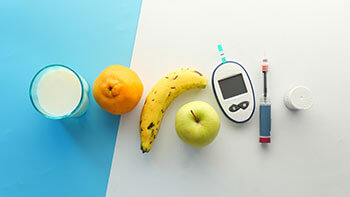Diet and lifestyle play a role in heart disease prevention. It is estimated that 80% of heart disease cases can be prevented with lifestyle changes that include a nutritious diet, regular exercise, and smoking cessation.1 Outlining a nutritious dietary pattern to your patients is a valuable first step in helping them make beneficial lifestyle changes to prevent heart disease.
Create a balanced plate
Heart disease remains the second-leading cause of death in Canada, and about 2.6 million Canadians live with heart disease.2 Numerous studies show that the best dietary patterns for heart disease prevention include the Mediterranean dietary pattern and Dietary Approaches to Stop Hypertension (DASH).3,4 Both of these eating patterns:
- Contain milk, dairy products, vegetables, fruit, whole grains, legumes, poultry and fish
- Contain mostly whole foods and few ultra-processed foods
- Reduce red meat and sugar intake
At breakfast, lunch and dinner, patients can create balanced meals based on these nutritious dietary patterns by:
- Filling half the meal with vegetables and fruit. These can be fresh, frozen, canned, raw or cooked
- Filling a quarter of the meal with protein rich foods, such as milk, yogurt, cheese, eggs, legumes, fish or poultry
- Filling a quarter of the meal with whole grains, such as oatmeal, barley, brown rice, or whole grain bread, cereals or noodles
People who eat more ultra-processed foods are at a greater risk of developing cardiovascular, coronary heart, and cerebrovascular diseases.5 This is due to both the ingredients and the processing methods used to create these foods.
Download the patient brochure for the heart health benefits of milk
Ingredients in these foods include added sugar, salt, fat, additives, preservatives, colours, flavours, gums and emulsifiers. Common processing methods include fractioning, hydrolysis, hydrogenation, extrusion, moulding and pre-frying.6 Whole foods do not contain these ingredients or undergo this level of processing, making them a more nutritious choice.
Here are some examples of whole vs. ultra-processed foods:
| WHOLE FOOD |
ULTRA-PROCESSED FOOD |
| Milk |
Cola, soda, sweetened, plant-based beverages |
| Fruit |
Fruit-flavoured candy |
| Vegetables |
Potato or corn chips |
| Chicken breast |
Chicken nuggets |
| Rice or pasta |
Powdered, seasoned rice or pasta |
| Olive oil |
Margarine |
Currently, Canadians get 50% of calories from ultra-processed foods, which has negative effects on heart health. Encourage patients to follow a balanced plate and eat more whole foods instead.
Download the fact sheet for the heart health benefits of milk
Dietary Patterns for heart health
Both the Mediterranean and the DASH eating patterns have been widely studied and are recommended for heart disease prevention. They both include dairy foods as a vital part of the eating pattern, and are also rich in vegetables, fruit, whole grains and legumes.
A study published in the American Journal of Clinical Nutrition looked at the effect of a Mediterranean eating pattern supplemented with additional dairy foods to see the impact on cardiovascular risk factors.7 Researchers found that the Mediterranean plan with added dairy resulted in significantly lower blood pressure, higher HDL “good” cholesterol, and lower triglycerides compared to the low-fat diet.
DASH eating plans are specifically meant to lower blood pressure levels to reduce heart disease risk.8 The DASH pattern is rich in potassium, magnesium, calcium and protein, which are all nutrients found in milk. The synergy of these nutrients leads to blood pressure reduction.
Nutrients in milk
Milk contains protein plus 14 essential vitamins and minerals. Many of these nutrients play a role in heart disease prevention. Vitamins found in milk that play a role in heart health include vitamin D, vitamin B6 and vitamin B12.
Minerals such as potassium and magnesium help lower blood pressure. And minerals like selenium and zinc are part of the pathways that regulate inflammation and oxidative damage, so they may play a role in reducing heart disease risk.
Read more from Hospital News: The heart health benefits of milk
Tips for your patients
If patients ask for nutrition advice, start with these tips.
- Choose whole foods more often than ultra-processed foods.
- Build meals using these proportions: ½ plate vegetables and fruit; ¼ plate whole grains; ¼ plate protein.
- Aim for 2-3 servings of milk or dairy products each day. One serving of dairy is equal to a cup of milk or yogurt, or 1.5 ounces of cheese.10











